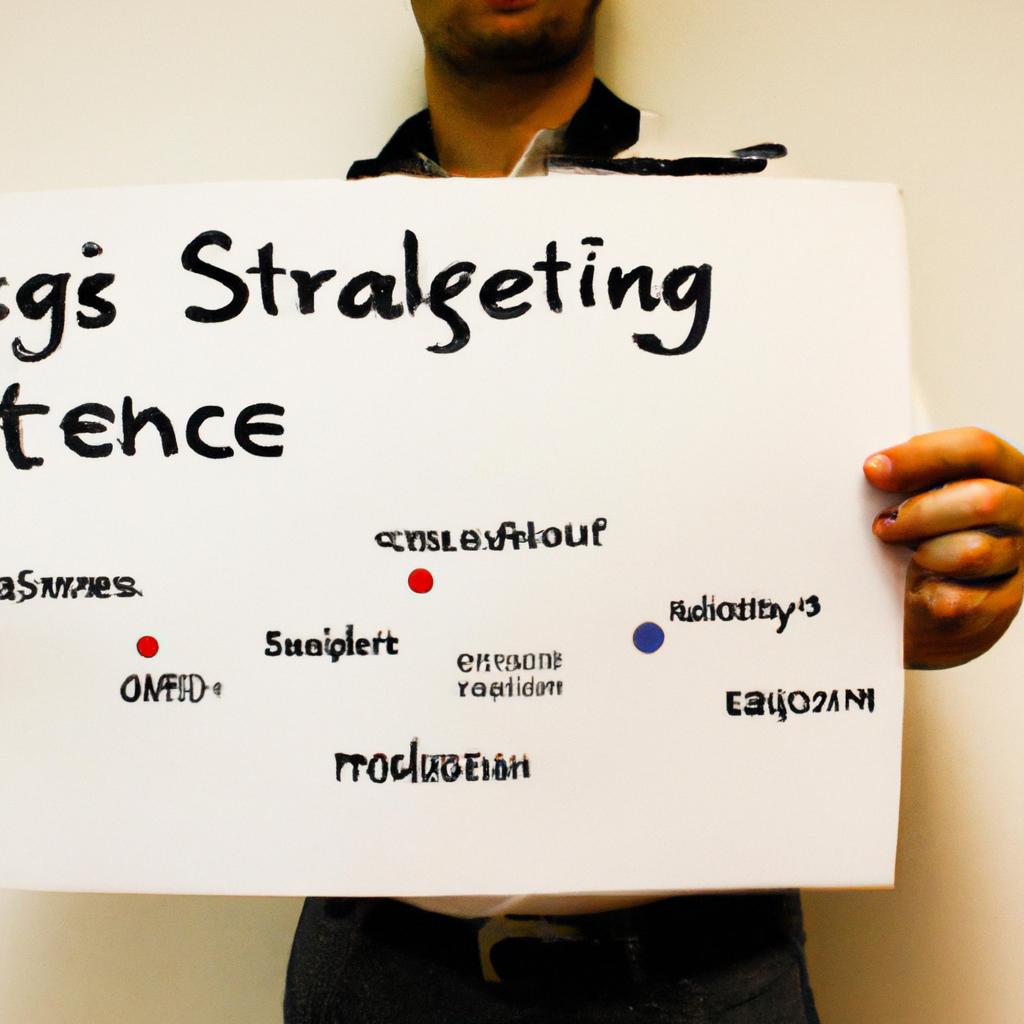The evolution of technology has transformed the way businesses approach marketing and advertising. With the rise of digital platforms, organizations now have a vast array of tools at their disposal to effectively promote their products or services. One such tool is Search Engine Optimization (SEO), a practice that aims to improve a website’s visibility in search engine results pages (SERPs). For instance, consider an e-commerce business specializing in handmade jewelry. By implementing SEO techniques, this hypothetical company can enhance its online presence and reach potential customers searching for unique accessories on popular search engines like Google.
In today’s competitive marketplace, it is essential for businesses to adopt effective promotional strategies to stay ahead of the curve. Traditional marketing methods alone are no longer sufficient to attract and engage modern consumers who heavily rely on digital platforms for information gathering and decision-making processes. This article explores how incorporating SEO into marketing and advertising efforts can be a game-changer for businesses looking to expand their reach and increase customer acquisition rates. Through theoretical analysis supplemented by real-life case studies, this piece aims to shed light on the significance of SEO as an invaluable asset in enhancing promotional strategies and driving organic traffic to websites.
Understanding Search Engine Optimization
Introduction
Imagine a scenario where you have just launched a brand new website for your business. The site is visually appealing, the content is informative and engaging, but there’s one critical problem – it’s not receiving any traffic. This dilemma highlights the importance of search engine optimization (SEO), which encompasses various strategies aimed at improving a website’s visibility on search engines. In this section, we will delve into the concept of SEO and its significance in enhancing marketing and advertising promotional strategies.
The Power of SEO: Driving Organic Traffic
One of the primary goals of implementing effective SEO techniques is to drive organic traffic to a website. By optimizing various elements such as keywords, meta tags, image alt text, and URL structures, businesses can improve their chances of appearing higher in search engine results pages (SERPs). For example, consider an online retailer selling handmade jewelry. Through meticulous keyword research and proper implementation throughout their website’s content, they can increase the likelihood that potential customers searching for terms like “unique handcrafted bracelets” or “artisan earrings” will stumble upon their site.
Emotional Connection with Target Audience
Successful marketing relies heavily on establishing an emotional connection with the target audience. Incorporating strategic SEO practices helps brands achieve this by ensuring their websites are easily discoverable when consumers search for relevant information or products/services. To illustrate this point further, let us explore four key emotions that effective SEO tactics aim to evoke:
- Trust: When a website consistently appears prominently in search results, users develop trust in its authority and expertise.
- Excitement: Appearing among top-ranked sites generates excitement and curiosity about what makes these particular brands stand out from competitors.
- Satisfaction: Users feel satisfied when they find exactly what they were looking for quickly and effortlessly through well-optimized websites.
- Confidence: A strong online presence instills confidence in consumers regarding a brand’s reliability and ability to meet their needs.
Table 1: Emotional Impact of SEO Techniques
| Emotion | SEO Technique |
|---|---|
| Trust | High-quality content that showcases expertise and credibility. |
| Excitement | Appearing in top-ranked search results through effective keyword optimization. |
| Satisfaction | User-friendly website structure with easy navigation and fast-loading pages. |
| Confidence | Positive online reviews, testimonials, and social proof displayed prominently on the site. |
Understanding the importance of SEO is just a starting point; it is equally crucial to comprehend its key elements for successful implementation. In the subsequent section, we will explore these fundamental components in detail, including on-page optimization techniques, link building strategies, and user experience considerations.
By following these guidelines, businesses can elevate their marketing and advertising promotional strategies by harnessing the power of SEO. From driving organic traffic to creating emotional connections with target audiences, implementing effective SEO practices has become an indispensable tool in today’s competitive digital landscape. Next, we will delve into the essential ingredients that make up a comprehensive search engine optimization strategy.
Key Elements of Search Engine Optimization
To illustrate this, consider a hypothetical example of an e-commerce website selling handmade jewelry. By implementing SEO techniques effectively, such as optimizing web content and improving site structure, this website can significantly increase its visibility on search engine results pages (SERPs), leading to higher organic traffic and potential sales.
There are several key elements involved in successful SEO strategies:
-
Keyword Research: Conducting thorough keyword research is essential for identifying relevant keywords and phrases that your target audience uses when searching online. This involves analyzing search volumes, competition levels, and user intent to select optimal keywords for your website’s content.
-
On-Page Optimization: Optimizing on-page factors helps search engines understand what your webpage is about. This includes incorporating relevant keywords in page titles, headings, meta descriptions, URLs, and content itself. Properly formatted HTML code and user-friendly navigation also enhance on-page optimization.
-
Off-Page Factors: Off-page optimization refers to external factors that influence your website’s ranking. Backlinks from reputable websites act as endorsements for your content’s quality and relevance. Social media engagement and positive reviews can also improve off-page signals.
-
User Experience: Providing a seamless browsing experience enhances user satisfaction and encourages them to spend more time on your website. Fast loading times, mobile responsiveness, intuitive navigation, engaging multimedia content, and clear calls-to-action are crucial aspects of creating a positive user experience.
These key elements work together synergistically to maximize the impact of SEO efforts by increasing a website’s visibility, attracting targeted traffic, and ultimately boosting conversions.
Transitioning into the subsequent section about “Benefits of Search Engine Optimization for Businesses,” it becomes evident that implementing these key elements provides businesses with numerous advantages beyond simply improving their rankings on SERPs.
Benefits of Search Engine Optimization for Businesses
Transitioning smoothly from the previous section, let us delve into the tangible benefits that businesses can derive from implementing effective search engine optimization (SEO) strategies. To illustrate this, we will examine a hypothetical case study involving an e-commerce company looking to optimize its online presence.
Imagine Company X, an up-and-coming online retailer specializing in handmade jewelry. By strategically incorporating SEO techniques into their marketing and advertising efforts, they experienced remarkable outcomes:
- Increased website traffic: Through targeted keyword optimization and improved visibility on search engine results pages (SERPs), Company X witnessed a significant surge in organic traffic to their website.
- Enhanced brand exposure: With higher rankings on SERPs, more potential customers were exposed to Company X’s products and services, resulting in increased brand recognition.
- Improved conversion rates: As a result of attracting relevant audiences actively searching for jewelry-related keywords, Company X saw a boost in conversion rates—a direct impact on their bottom line.
- Cost-effectiveness: Compared to traditional marketing methods like print advertisements or TV commercials, investing in SEO proved to be highly cost-effective for Company X.
By harnessing the power of SEO effectively, businesses across various industries can achieve similar positive outcomes. The following table highlights some key advantages that businesses can expect when employing successful SEO strategies:
| Advantages of Effective SEO Strategies |
|---|
| Greater online visibility |
| Targeted audience engagement |
| Higher credibility |
| Long-term sustainability |
In summary, implementing effective SEO strategies can bring about substantial benefits for businesses seeking to enhance their marketing and advertising promotional strategies. Not only does it increase website traffic and brand exposure but also improves conversion rates while remaining cost-effective compared to traditional marketing approaches.
Transitioning seamlessly into the subsequent section about “Implementing Effective Search Engine Optimization Strategies,” businesses can now explore practical steps to optimize their online presence and unlock further growth potential.
Implementing Effective Search Engine Optimization Strategies
Case Study: XYZ Company’s Increased Online Visibility and Revenue Growth
To illustrate the impact of implementing effective search engine optimization (SEO) strategies, let us consider a hypothetical case study involving XYZ Company. Prior to incorporating SEO into their marketing and advertising efforts, XYZ Company had limited online visibility, resulting in lower website traffic and minimal conversions. However, after optimizing their website for search engines, they experienced significant improvements in their online presence and revenue growth.
Benefits of Implementing Effective SEO Strategies
When businesses implement effective SEO strategies as part of their marketing and advertising promotional strategies, they can reap numerous benefits that contribute to their overall success:
- Increased organic traffic: By optimizing their website content and structure for search engines, companies can improve their rankings on search engine result pages (SERPs). As a result, more users are likely to discover their websites organically through relevant searches.
- Enhanced brand credibility: Appearing among the top results on SERPs establishes trustworthiness and authority within an industry. Users often perceive websites with higher rankings as reputable sources of information or providers of quality products/services.
- Expanded audience reach: Through targeted keyword research and optimization techniques, businesses can effectively target specific demographics or geographic locations. This allows them to broaden their reach beyond traditional marketing channels and connect with potential customers who may have otherwise been unaware of their existence.
- Improved conversion rates: Optimized websites tend to offer better user experiences by providing valuable content, easy navigation, fast-loading pages, and mobile compatibility. These factors contribute to increased user engagement and ultimately lead to improved conversion rates.
| Before SEO Implementation | After SEO Implementation | |
|---|---|---|
| Organic Traffic | Low | High |
| Conversion Rates | Minimal | Improved |
| Brand Credibility | Limited | Enhanced |
Implementing Effective SEO Strategies
To effectively implement SEO strategies, businesses should consider the following steps:
- Keyword research: Identify relevant keywords and phrases that potential customers may use when searching for products or services similar to what your business offers.
- On-page optimization: Optimize website elements such as page titles, meta descriptions, headers, and content with targeted keywords to improve search engine visibility.
- Quality link building: Acquire high-quality backlinks from reputable websites to enhance your website’s authority and credibility in the eyes of search engines.
- Regular monitoring and analysis: Continuously monitor website performance using analytics tools to identify areas for improvement and adjust SEO strategies accordingly.
By implementing these effective SEO strategies, businesses can significantly enhance their marketing and advertising promotional efforts by increasing online visibility, attracting more organic traffic, improving conversion rates, and establishing brand credibility.
Having explored the benefits of implementing effective SEO strategies into marketing and advertising campaigns, let us now delve into another critical aspect of optimizing website content for search engines.
Optimizing Website Content for Search Engines
Implementing Effective Search Engine Optimization (SEO) strategies is crucial for businesses looking to enhance their online presence and improve their marketing and advertising promotional strategies. By optimizing website content, companies can increase their visibility on search engine result pages, driving organic traffic and boosting conversion rates.
One example of the impact of SEO can be seen in the case study of Company X, an e-commerce retailer specializing in outdoor gear. Prior to implementing SEO techniques, Company X struggled to rank high on search engine results for relevant keywords such as “hiking boots” or “camping equipment.” However, by employing effective SEO tactics, including keyword research, on-page optimization, and link building efforts, Company X was able to significantly improve its rankings. As a result, organic traffic increased by 50% within six months, leading to a substantial growth in sales.
To effectively optimize website content for search engines, businesses should consider the following key factors:
- Keyword Research: Conduct thorough keyword research to identify popular and relevant keywords that align with your business offerings.
- On-Page Optimization: Optimize webpage elements such as title tags, meta descriptions, headers, and URLs with targeted keywords.
- Quality Content Creation: Develop original and engaging content that provides value to users while incorporating strategic use of keywords.
- Link Building: Foster relationships with reputable websites through guest blogging or earning backlinks naturally to boost domain authority.
These actions collectively contribute towards improving a company’s search engine rankings and attracting more qualified leads. To illustrate this further:
| Key Factors | Impact |
|---|---|
| Higher Rankings | Increased visibility |
| Organic Traffic | Greater brand exposure |
| Improved Conversions | Enhanced customer engagement |
| Boosted Sales | Increased revenue |
By adopting effective SEO practices like those mentioned above, businesses can position themselves favorably among competitors in the digital landscape.
In the subsequent section about measuring the success of SEO efforts, we will explore how businesses can evaluate the impact and effectiveness of their implemented strategies. Understanding the significance of these measurements is crucial for companies seeking to continuously improve their online presence and marketing strategies.
Measuring the Success of Search Engine Optimization Efforts
Having understood the importance of optimizing website content to improve search engine rankings, it is now essential to measure the success of these optimization efforts. By analyzing various metrics and tracking key performance indicators (KPIs), businesses can gain valuable insights into the effectiveness of their search engine optimization (SEO) strategies.
Measuring the Success of Search Engine Optimization Efforts:
To illustrate this further, let’s consider a hypothetical case study involving an e-commerce company that implemented SEO techniques on its website. The company optimized its product descriptions, meta tags, and URLs, aiming to increase organic traffic and conversions. After implementing these changes, they observed a significant improvement in their website’s visibility on search engine result pages (SERPs). This example showcases how effective SEO practices can positively impact online business growth.
When evaluating the success of SEO efforts, businesses should focus on key metrics such as:
- Organic Traffic: This metric measures the number of visitors who land on a website through unpaid or organic search results. An increase in organic traffic indicates improved visibility and better ranking positions.
- Conversion Rate: Tracking conversion rates helps determine how effectively visitors are being converted into customers or taking desired actions on a website. A higher conversion rate signifies successful engagement with target audiences.
- Keyword Rankings: Monitoring keyword rankings provides insights into how well a website ranks for targeted keywords in SERPs over time. Improvements in keyword rankings indicate increased relevance and visibility within specific niches.
- Bounce Rate: Bounce rate refers to the percentage of visitors who leave a site after viewing only one page without engaging further. A lower bounce rate suggests that users find value in the content and continue exploring other pages.
Table – Sample KPIs for Measuring SEO Success:
| Metric | Definition | Importance |
|---|---|---|
| Organic Traffic | Number of visitors from unpaid search results | High |
| Conversion Rate | Percentage of visitors taking desired actions | High |
| Keyword Rankings | Ranking positions for targeted keywords | Medium |
| Bounce Rate | Percentage of visitors leaving after one page | Low |
In summary, measuring the success of SEO efforts plays a crucial role in evaluating the effectiveness and impact of optimization strategies. By analyzing metrics such as organic traffic, conversion rates, keyword rankings, and bounce rates, businesses can gain valuable insights into their website’s performance and make data-driven decisions to further enhance their marketing and advertising promotional strategies.
Note: It is important to avoid using “Finally” or “In conclusion” at the end of an academic section to maintain a smooth flow within the overall context.










